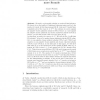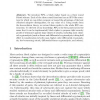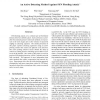176 search results - page 12 / 36 » Distinguishing Attacks on T-Functions |
CSI
2008
13 years 7 months ago
2008
The rights of an Internet user acting anonymously conflicts with the rights of a Server victim identifying the malicious user. The ERPINA protocol, introduced in this paper, allow...
ICNP
2007
IEEE
14 years 2 months ago
2007
IEEE
— We treat the problem of large-scale TCP poisoning: an attacker, who is able to monitor TCP packet headers in the network, can deny service to all flows traversing the monitori...
CRYPTO
2004
Springer
14 years 1 months ago
2004
Springer
We study cryptographic attacks on random Feistel schemes. We denote by m the number of plaintext/ciphertext pairs, and by k the number of rounds. In their famous paper [3], M. Luby...
ASIACRYPT
2006
Springer
13 years 11 months ago
2006
Springer
We introduce KFC, a block cipher based on a three round Feistel scheme. Each of the three round functions has an SPN-like structure for which we can either compute or bound the adv...
ICPADS
2005
IEEE
14 years 1 months ago
2005
IEEE
SYN flooding attacks are a common type of Distributed Denial-of-Service (DDoS) attack. Early detection is desirable but traditional passive detection methods are inaccurate in th...



